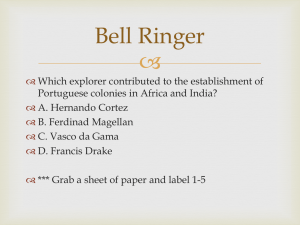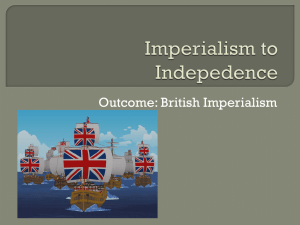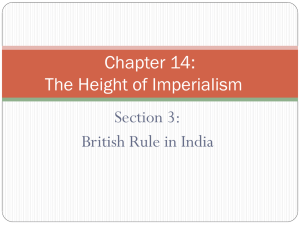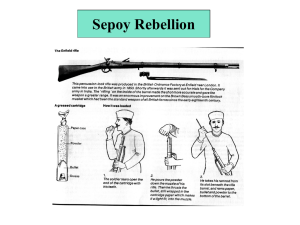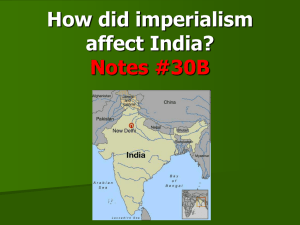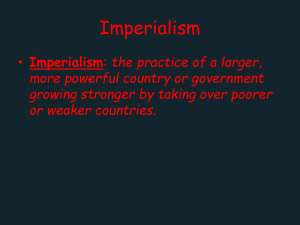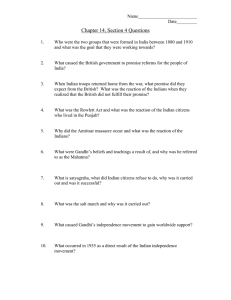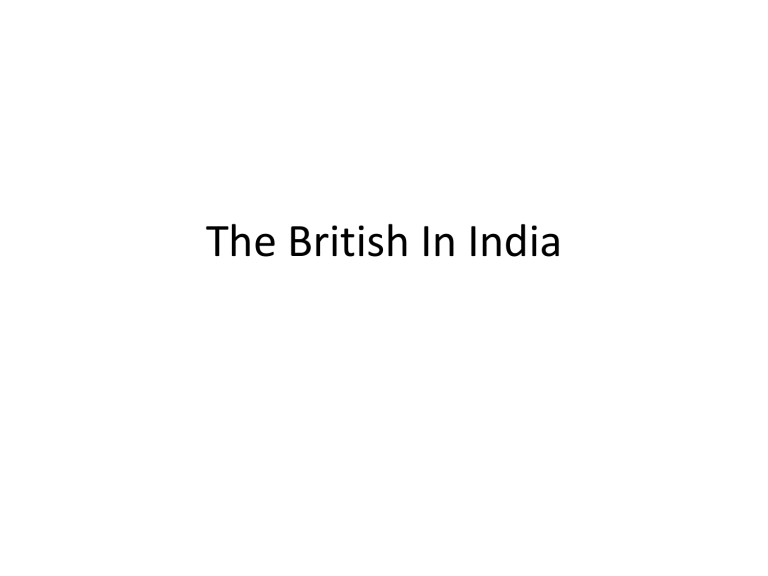
The British In India Spice Trade Draws Europe The Spice Trade • Pepper, cinnamon, rice, tea, cotton, indigo etc. all were in great demand in Europe • Very expensive due to taxes and tariffs by Italians and Turks British East India Company • The first part of Imperialism done in South Asia was by this trading company and not the British government! • The British East India Company was very powerful, because it controlled trade between Britain, India, and East Asia. – American History Connection: Tea Act and Boston Tea Party • It eventually controlled Bangladesh, Southern India, and Northern India along the Ganga River. British East India Company • Actually had its own monetary system in the areas it controlled. British East India Company • It controlled South Asia by keeping it in chaos. • Manipulated princes of Indian states, suggested each needed British support to keep throne • Played rulers against each other, kept India in chaos • Company’s army took over much of India, claiming it had to restore order How Did The British East India Company Change India? • Set up a new education system to teach English. • Created new laws: banned the practice of SATI---widows committing suicide by jumping into their husband’s cremation fires. • Spread Christianity • Destabilized and weakened local Indian princes Sati How Did The British East India Company Control South Asia? • Began to take over taxation of people –Used the same system as the Mughal empire • Promised “protection” • In 1850: 300,000 men in army. –Only 50,000 were British • 100,000 British men ruling over 200 million Indians Pair-Share Activity • Which of the changes made to India by the British East India Company do you think was most important and why? • Do this next to the last slide for British East India Company. Jewel in the Crown Reference Britain’s Jewel in the Crown” • India was Britain’s most valuable colony, or “jewel in the crown.” • Forced to produce raw materials for British manufacturing • Also forced to buy British goods “Jewel in the Crown” • Britain set up a railroad network to take raw materials from inside India to its ports Raw Materials Taken From India • • • • • • Tea Indigo Coffee Cotton Jute Opium Pair-Share Activity • Draw a crown with THREE peaks. • In each of the peaks, write down a reason as to why India was so important to Great Britain. • There were many reasons, so you need to decide on the three you think were the most important. • Do this next to the last slide for the Jewel of the Crown. YouTube Clip • https://www.youtube.com/watch?v=oNWTXa OotEA • BBC • Running time of ten minutes Indian Rebellion/Resistance to British Rule Indians Rebel • By 1850 most Indians resented that Great Britain owned their country • Indians were angry Britain controlled all useful land in their country • Indians were angry at attempts to forcefully convert them to Christianity ■ Indians were angry at the constant racism expressed towards them by the British Sepoys and Sepoy Mutiny or Rebellion (Depends on Viewpoint) Sepoys • Indians who joined British armies in India – Resented by other Indians Sepoy Mutiny: Causes (TEST QUESTION) • Underlying Causes – Religious Frictions: • Some British officers actively attempted to convert the sepoys to Christianity although the British East India Company discouraged it. • The sepoys resented imposing Christianity and Christian laws in India. – Doctrine of the Lapse: • The Company automatically seized land from a feudal leader who died without leaving an heir. – Unfair justice system toward Indians: • British officers accused of crimes against Indians were granted multiple appeals and advantages when being tried. Sepoy Mutiny: Causes (Test Question) – High Caste Sepoys: • The Bengal Army of sepoys were recruited from a higher caste of Indians. • Therefore, if the high caste sepoys were considered to be "polluted", they would have to expend considerable sums of money on ritual purification before being accepted back into society. • Immediate Cause – The Enfield Rifle: – It required the soldier to bite the cartridge and hold the ball in his mouth when loading the rifle. – The belief that the cartridge was lubricated with animal fat (either pork or beef) offended both Muslims and Hindus. Sepoy Mutiny • Sepoys in Meerut refused to use cartridges; thought it plot to make them abandon Hinduism and Islam • Sepoys punished for protesting • In response, northern Indian sepoys rose up against British • Eventually gained control of Delhi • Violence of rebellion ferocious • Both sides committed atrocities • Sepoys killed British officers, as well as wives, children • British captured mutineers strapped to cannons and shot; villages burned • Fighting continued two years Effects/Results Sepoy Mutiny • Sepoy rebelled against East India Company rule –Resulted in the end of 100 years of company rule in India • British government took direct control to protect their valuable trading empire and ruled from 1858 to 1947 • The Indians could not unite against the British due to weak leadership and serious splits between Hindus and Muslims. • This is a British political cartoon that appeared after the Sepoy Mutiny. • You see that the British perceived their violent crushing of the rebellion as justice. • This again speaks to why the British refer to the event as a mutiny, while the Indians refer to it as a rebellion. YouTube Clip • https://www.youtube.com/watch?v=SzBj4LN6 hMg • Running time of 4:56 minutes YouTube Clip • https://www.youtube.com/watch?v=_muPzrF 2jjA • Running time of ten minutes Pair-Share Activity • The British refer to this event as a Mutiny, while the Indians refer to this event as a Rebellion. Two clearly different interpretations. • Based upon what you have learned, which viewpoint do you agree with and why? • Write this next to the last slide about the Sepoys. The British Raj Turning Point • 1858 British government took direct control over India (because of the Mutiny) • Raj: time period when India was under Great Britain’s control from 1857-1947 (TEST QUESTION) Raj • India was divided into 11 Provinces and 250 districts sometimes a handful of officials would be the only British amongst millions of Indians in a district • Mutiny increased distrust between British and Indians: it fueled more British racism towards Indians India as a British Colony • Colony of colony—the “jewel in the crown” of the British Empire, with political and financial rewards, national pride • For Indians, British rule source of frustration and humiliation • Frustration gave rise to powerful feelings of nationalism The Raj • Era of British rule in India often called British Raj, Hindi word meaning “rule” • Administration carried out by government agency, Indian Civil Service (ICS) ICS • Though ruling India, most ICS officials British • ICS employed very few Indians • Many educated Indians frustrated at having no say in own government Westernization • Many British thought they were superior – Segregated neighborhoods; exclusive clubs – Westernized Indians • Prejudiced, thought Indians incapable of governing selves A Life of Leisure! Lady Curzon, 1904 Life under the British Raj Raj Building Projects • During Raj, British built railroads, roads, canals in India • By 1910, India had fourth-largest railroad network in world • British invested in transportation to move troops; help sell British products Raj Commerce • India important market for British manufactured goods • Also source of raw materials like cotton, tea, indigo, jute • Taxes from Indian landowners paid for administration of India, Indian army Raj Impact • British manufactured goods devastated India’s pre-existing textile industry • Had been major exporter; British closed factories to prevent competition • Mid-1800s, India primarily exported raw materials, not manufactured goods Life Under the Raj • Stability and surprisingly honest government. • Modernization: – Many Indians educated – Women even allowed to attend college. – Modernized the country—railroads, highways, telegraph, postal service, etc. • Religious reform – Outlawed sati and female infanticide. – Reigned in the thuggee cult (“thugs”). Pair-Share Activity • Based upon what you know thus far about British Imperialism in India, do you think there were more positives or more negatives for the Indian people? Why? • Do this next to the last slide for British Raj. Role of World War One Rowlatt Act World War One and India • Great Britain got 1 Million Indians to enlist in the British army to fight in World War I • Britain promised Indians self-government in exchange for them enlisting in the British army • 1918 Indian troops returned home: expected Britain to fulfill its promise • Instead Indian troops were treated as second class citizens again by Great Britain • Many Indians committed acts of violence against British in India in response. Rowlatt Act (1919) • • • So the British government passed the Rowlatt Act. Allowed British gov’t to jail protestors for 2 years with no trial Violent protests by Indians in Punjab (province with most Indian World War I veterans) Pair-Share Activity • What are your thoughts on the Rowlatt Act? • Can you think of any laws from American History that parallel the Rowlatt Act? Explain. • Do this next to the last slide for the Rowlatt Act. Amritsar Massacre Amritsar Massacre Date: April 13, 1919 The Story Behind THE AMRITSAR MASSACRE The Amritsar Massacre occurred a few months after the end of WWI when a British female missionary reported that she had been molested on a street in the city of Amritsar. Britain issued an order requiring all Indians using that street to crawl its length on their hands and knees, and the public whipping of natives who came within a certain distance of British policemen. In 1919, Indians gathered in Amritsar to protest these extraordinary measures. The throng, penned in a narrow space, had been peacefully listening to the story of victims when, without warning, 50 British troops fired into the gathering. For 15 minutes 1,650 rounds of ammunition were unloaded into the screaming, terrified crowd, some of whom were trampled by those desperately trying to escape. • “The Indians were ‘packed together so that one bullet would drive through three or four bodies’; the people ‘ran madly this way and the other. When fire was directed upon the centre, they ran to the sides. The fire was then directed to the sides. Many threw themselves onto the ground, and fire was then directed on the ground. This continued for eight or ten minutes, and it stopped only when the ammunition had reached the point of exhaustion…” Winston Churchill Site of massacre today Alley that prevented the use of tanks Following the massacre…. • The Amritsar Massacre was a turning point. • After it, Gandhi became the leader of the Indian nationalists in the Indian Congress Party. • He resolved to work towards Indian independence by a series of major campaigns against the British. YouTube Clip • • • • • https://www.youtube.com/watch?v=MRxc_f-7zm8 History 101 - Amritsar Massacre Houston Public Media Published on Feb 25, 2015 This educational segment, "History 101," provides brief history of the Amritsar Massacre during the British rule of India as mentioned during Episode 8 of Season 5 from the PBS Masterpiece Classic "Downtown Abbey" featured on the live after-show "Manor of Speaking." • Initial broadcast date: February 22, 2015 (Episode #308) • Running time of 2:28 minutes YouTube Clip • • • • • • • https://www.youtube.com/watch?v=IUgLbd7-xik BBC News Inside Amritsar's massacre gardens luckyclipz Published on Feb 20, 2013 Running time of 2:12 minutes David Cameron has become the first serving UK prime minister to pay his respects at the scene of one of the bloodiest massacres in British history. Mr Cameron was visiting Amritsar in the Indian state of Punjab on Wednesday, at the end of a three-day trade trip to India. Hundreds of people at a public meeting were shot dead by British troops at the Jallianwala Bagh public gardens in Amritsar on 13 April 1919. The BBC's Sanjoy Majumder looks around the gardens, where memories of the massacre are carefully preserved. Pair-Share Activity • Often through the study of history, you find that an individual can simultaneously be viewed as a hero and as a villain. This was seen with Nelson Mandela, • The British honored Dyer as a hero for his actions. The Indians saw him as a criminal. • Based upon what you have learned, how do you view him and why? • This should be done next to the last Amritsar slide.
